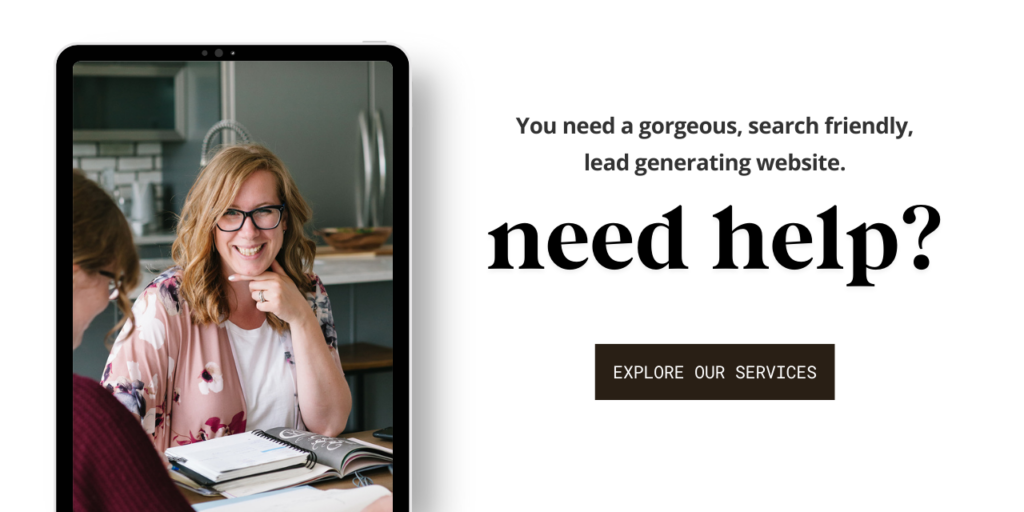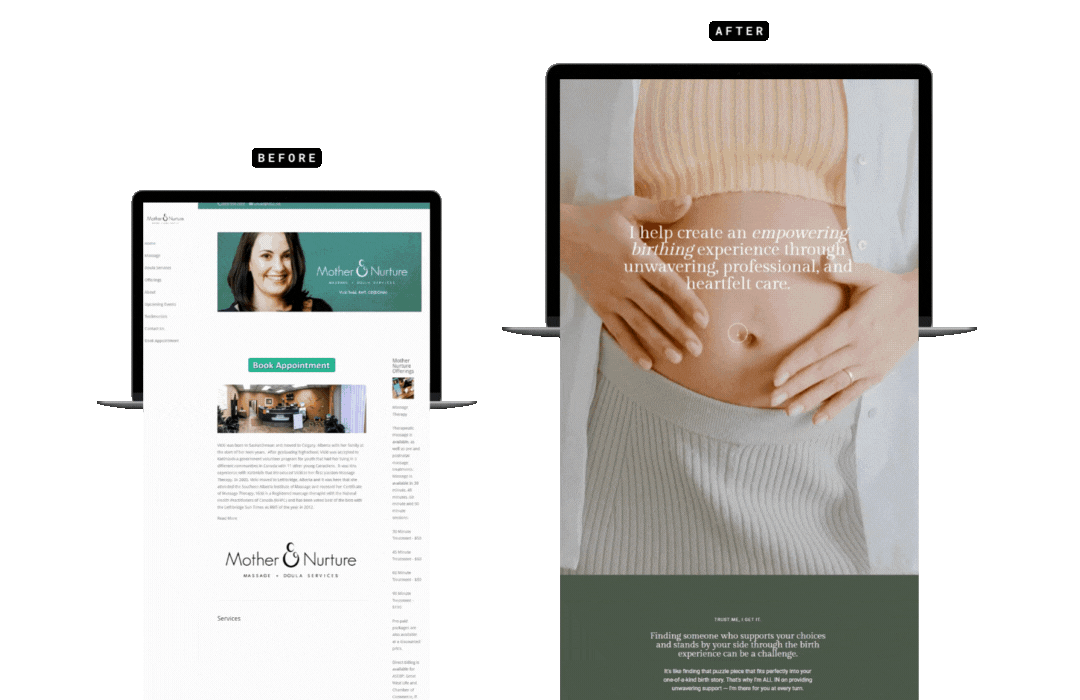How to Switch Website Platforms Without Losing SEO
Worried about losing your SEO when you move your website platform? I feel ya.
As a website designer who’s helped many business owners switch from Wix to Squarespace to WordPress to Showit, I know how stressful it can be to switch website platforms without losing SEO. Until I did it a few times, I felt pretty much exactly like that GIF 👆 Gah!!
With the right approach, you can not only maintain your search engine rankings but also give your website a fresh start. And who knows, you might even see a boost!
In this guide, I’ll walk you through the step-by-step process of migrating your website, focusing on Very Important Things like permalink structure, content migration, and meta data.
I’ll try to stay away from getting too technical, but still cover all of your bases.
We eat, sleep, and breathe this stuff so if you run stuck, we’re here! 😉
Table of Contents

Expect a temporary dip in your SEO when you switch website platforms
Don’t panic if your website rankings take a temporary dive after migration. It usually takes a second for Google to catch up with your changes, so hang tight.
In fact, a study by Moz found that 80% of websites lose SEO rankings when migrating their website to a new platform. But don’t worry, your site will likely recover within 3-6 months, depending on the complexity of the migration and the effectiveness of SEO efforts. And in some cases, you’ll actually see your rankings improve!
Post-launch, you might get scary messages from Google saying that certain pages haven’t been indexed. I see them roll through all the time and they can still be very stressful. Remember, they’re often temporary. Here’s a breakdown of why this happens:
- Indexing Delays: Google’s crawlers take time to discover and index new or updated content, which means there’ll be a temporary delay in indexing.
- Technical Issues: If there are technical problems with your website (think broken links, incorrect redirects, or server errors), Google’s crawlers might have trouble accessing or indexing certain pages. This is the one to keep a really close eye on! They’re an easy fix, as long as you don’t have a million of them.
- Redirects: When you redirect old pages to new ones, it can take some time for Google to update its records. While that’s happening, you might see temporary indexing issues.
Most of the time, these unindexed pages fall into two categories:
- Pages that didn’t work in the first place: These might be pages with errors, broken links, or outdated content that were never properly indexed. It’s sucky. And it happens. It’s okay.
- Pages that you’re redirecting to now: While you’re setting up redirects, Google might still be indexing the old pages before it recognizes the redirect.
It’s important to remember that these messages are often temporary. Once Google’s crawlers catch up with your changes, the indexing issues should resolve. To help speed up the process, submit your new sitemap to Google Search Console and monitor your website’s health using tools like Google Analytics.

How to successfully switch to a new website platform without losing SEO: key factors
Permalink structure
Permalinks are the biggest pain in the butt, AND the biggest deal when switching over a website, especially if you’ve got a lot of content. Broken links have the potential to do a lot of damage, so make sure you cover your bases here!
- Keep it consistent: Try to maintain the same permalink structure as much as possible. This helps search engines understand the relationship between your pages.
- Redirect wisely: If you need to change permalinks, use 301 redirects to tell search engines that the content has moved permanently. (Think of it like setting up a forwarding address for your website. That way, even if someone stumbles across the old link, they’ll still be able to find your content quickly & easily.)
Content
You likely have some old blog posts that are outdated or aren’t doing a heck of a lot for your business.
Give them the ol’ spit & polish and repost them! Incorporate the latest data, statistics, or trends to make it relevant and valuable and of course, re-optimize for SEO with updated keywords or meta descriptions.
If it’s REALLY time for that content to retire, it’s completely okay to remove it! Do be sure set up 301 redirects to point to similar or related pages though.
As you’re going through your old content, make sure you’re optimizing your images. They should have alt text and be named appropriately to help search engines understand their content. (This is one of the things that’s sooooo easy to let slip, especially if you’re creating content under the wire.)
A study by SEMrush revealed that 40% of websites have technical SEO issues after migration, such as broken links, incorrect meta tags, or slow load times. That’s why it’s important to work with a skilled website designer who can ensure everything is set up correctly.

Meta data
Don’t forget the basics!
Transfer or update your meta titles, meta descriptions, and header tags to your new platform. That way not only do the search engines know what you’re all about, but when someone DOES find you on Google, your links are enticing enough for them to actually click through to your site — they’re a big (👏) deal (👏).
I love Showit for this part — it’s super easy to go through all of the pages and make sure that everything is up to snuff. It takes a bit of time to get those descriptions perfect, but it’s so satisfying to see your website pop up in search engines the way you want it to!
Site maps, robots, and search engine submission
Create new XML sitemaps for your new website and submit them to search engines. This helps them find and index your content!
It sounds complicated, but the biggest thing is REMEMBERING to do it after alllllllll the work you put into your new website design, and giving yourself a chunk of time to muddle your way through the process.
While you’re at it, review your robots.txt file to ensure it’s configured correctly for your new platform. This file tells search engines which parts of your website they can crawl.
And of course, let search engines know through tools like Google Search Console!
The benefits of dealing with all of this crap
I mean, you get a website update, which is pretty wicked. A new platform might mean more integrations, better design options, and improved performance — ALL really great things for your long-term SEO strategy and client experience!

Showit (my personal favourite, by a billion) offers a user-friendly interface and powerful SEO tools, making it a great choice for female service entrepreneurs. Compared to Squarespace and Wix, Showit provides more design flexibility and seamless integrations with popular business tools.
By following these nerdy guidelines, you can successfully move your website platform without losing SEO. Give yourself LOTS of time — it takes way longer than you think to work through all of the nitty gritty details!
And most importantly
Don’t stress about achieving perfection.
Remember that you don’t have to have 10/10/10 100 percent perfection to rank in search engines. For example, the page you’re on right now is scoring at 79 percent (low for us) and you found it! 👏
Do what you can with your website optimization. Then, dig deep into keyword research and focus on creating high-quality content that addresses your target audience’s needs.
Over time, your SEO will improve as you consistently publish valuable content! You’re going to get further, faster, and with less gray hair.
Key takeaways
- Don’t freak out about a temporary dip: Rankings might take a hit for a bit, but they’ll usually bounce back.
- Fix any broken links, redirects, and server errors: Make sure your website is squeaky clean and free of errors.
- Keep your content fresh: Update old posts, optimize images, and use those fancy meta tags.
- Use SEO tools: Submit sitemaps and keep an eye on your website’s health.
- Don’t stress about being perfect: Focus on creating awesome content that your audience loves!
Ready to take the plunge? Let’s work together to ensure a smooth and successful website migration!





